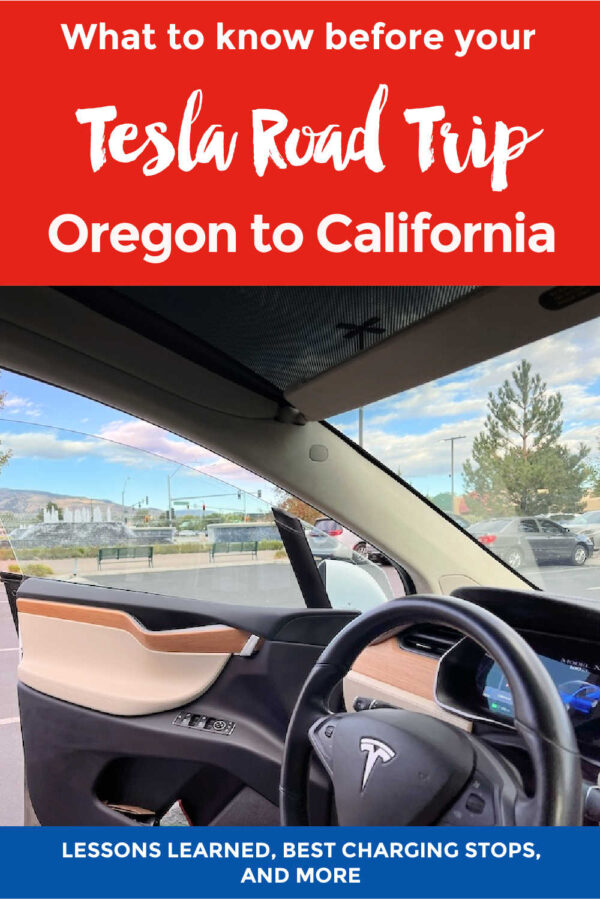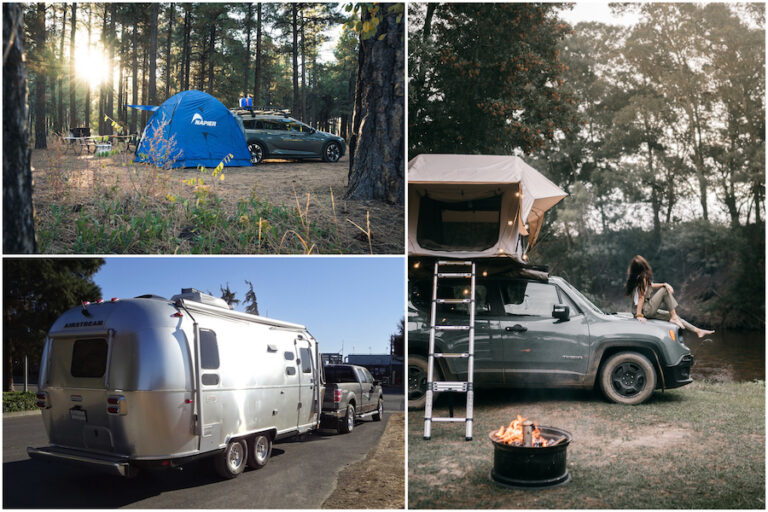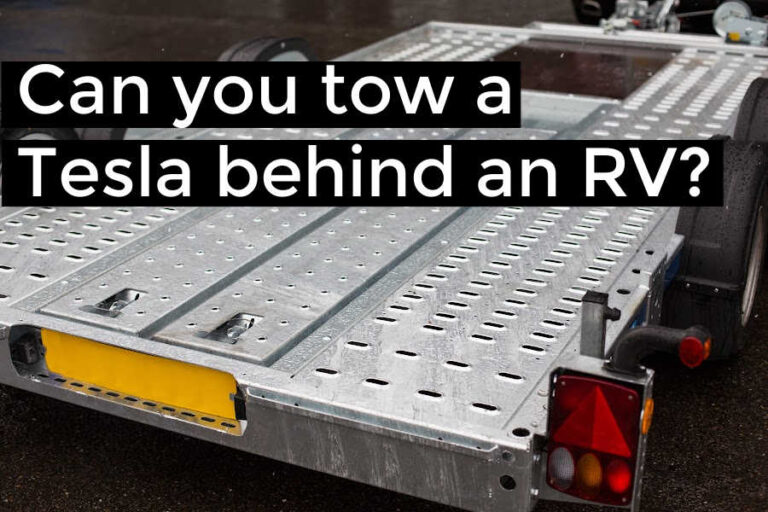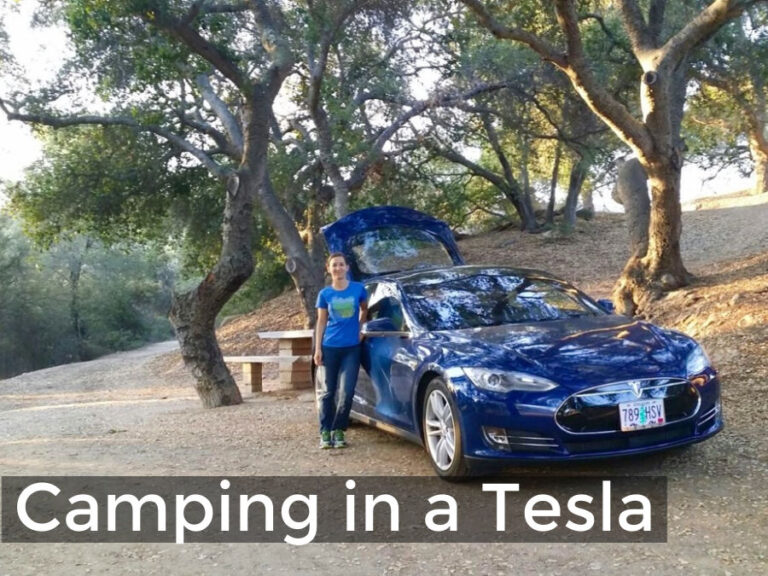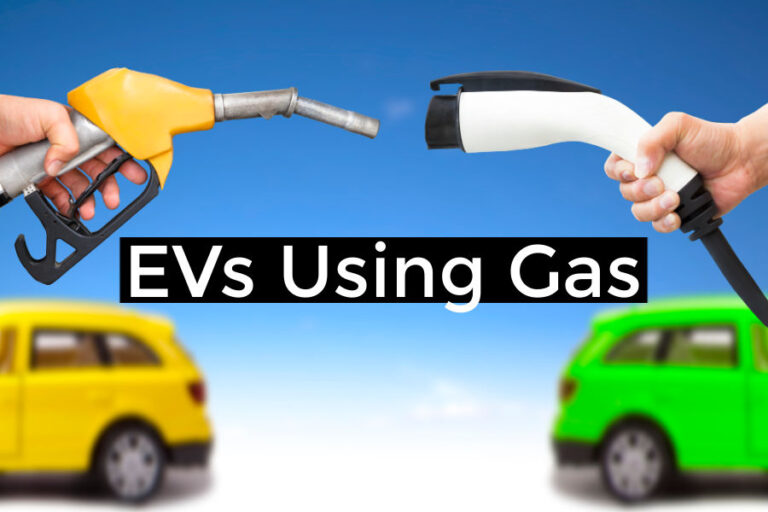We drove a Tesla from Oregon to California: Supercharger stops and lessons you should know
In September, we tried a 950-mile EV road trip from Oregon to California and back, driving a borrowed 2016 Tesla Model X.
Driving from just South of Portland to Los Angeles, we learned a lot about long-distance travel in an electric vehicle. This post is a collection of the lessons we learned, tips for managing range and charging, and a few of our favorite Tesla superchargers along the way.
Our EV road trip stats:
– 950 miles
– Mostly highways (I-5 and I-395)
– September, mostly warm and dry weather
– 2016 Tesla model X
– Portland/Salem, Oregon to Los Angeles, California
Preparing for our Oregon California Tesla Road Trip
When planning an EV road trip, especially one that spans nearly 1,000 miles, preparation is key. We used Tesla’s built-in navigation, which calculates your route and recommends charging stops based on your current range.
In addition to using Tesla’s route suggestions, we received a lot of helpful advice before hitting the road:
- Prepping the Car: We ensured the tire pressure was good, which is helpful for maintaining range; we packed our own portable tire air pump; and set the battery to charge to 90% shortly before departure.
- Charging Accessories: We carried essential charging accessories, including an adapter for home plugs, and got familiar with the car’s charging capabilities.
- Offline Maps: Since we would be driving through some remote areas, we downloaded Google Maps data for offline use, as a backup in case cell service dropped.
The most useful piece of advice? Always plan for a buffer on your range to account for unexpected changes, whether it’s speeding up on highways, dealing with hilly terrain, or adjusting to weather conditions.
Key Lessons Learned from our Tesla Road Trip
Efficient Driving and Range Management Tips
On the dashboard, Tesla predicts the charge you should have when you reach your destination. Since you don’t want to run out of charge, when that arrival prediction gets down past 10%, it’s risky.
One of the most important lessons we learned early on is to leave room for the unexpected.
For example, when we drove slightly faster than the speed limit through southern Oregon, we quickly saw our projected battery range drop faster. Similarly, driving uphill—such as the climbs near Ashland and the Tejon Pass—also ate into our range more quickly.
Another factor we discovered is that the car’s energy consumption can change based on weather and air filtration needs. While driving through areas affected by wildfire smoke, the Tesla’s air filtration system came in handy but also used more energy than usual.
Our solution? Charge until the Tesla predicts that we’ll reach the next charger with at least 20% of battery remaining. This rule of thumb helps prevent range anxiety and allows a buffer for unforeseen circumstances like detours, weather, or speeding.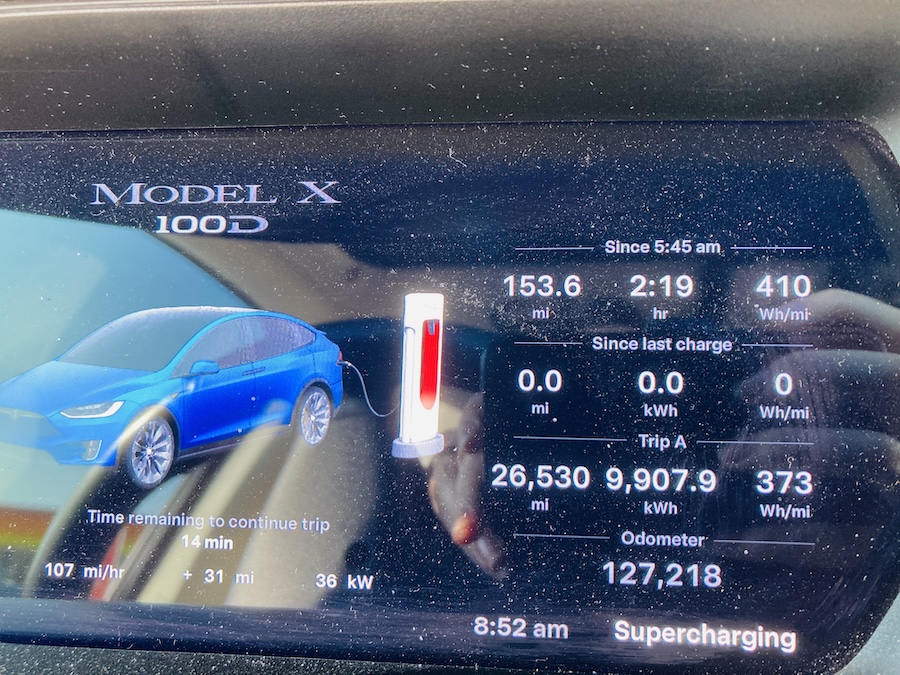
Finally, while climbing hills would significantly reduce our range (as we discovered near the California-Oregon border), descending hills added more miles back to our battery. On the downhill stretches returning home to Oregon, the Tesla had predicted that we’d arrive home with just 16% charge as we left the final charger, but we actually arrived with 25%.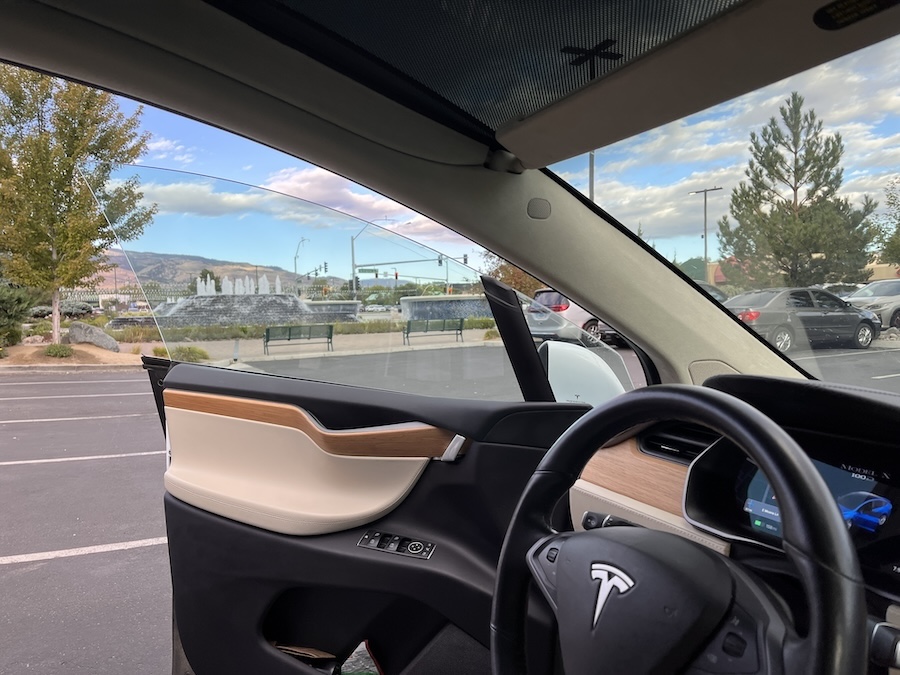
Managing Charging Stops
On longer stretches, charging stops became a welcome break, giving us a chance to stretch our legs, grab snacks, and explore the surrounding area. That said, it’s essential to plan extra time in your itinerary for charging.
I think our route took an extra 4 hours each way because of the charging stops. None took longer than an hour, but stops ranged from 10 – 50 minutes.
Tesla’s Supercharger network is extensive (especially in California and a lot of Oregon), and it’s generally reliable. But chargers can vary significantly in terms of charging efficiency and convenience to your route.
- The newest Superchargers and some other DC Fast Charger (Level 3) are 250 kW chargers. This takes 15-20 minutes to reach 80% charge.
*This is unless you have an older vehicle (like us), which has its own lower kW limit. Our car peaked around 180 kW. - Older Tesla Superchargers are 150 kW chargers or even 72 kW, which could take 40-50 minutes to reach 80%.
- Tesla Destination Charging or Wall Connectors (Level 2) take 8-12 hours for a full charge.
Fortunately, the Tesla will tell you which type of charger a location has, along with how many open stalls are expected when you arrive.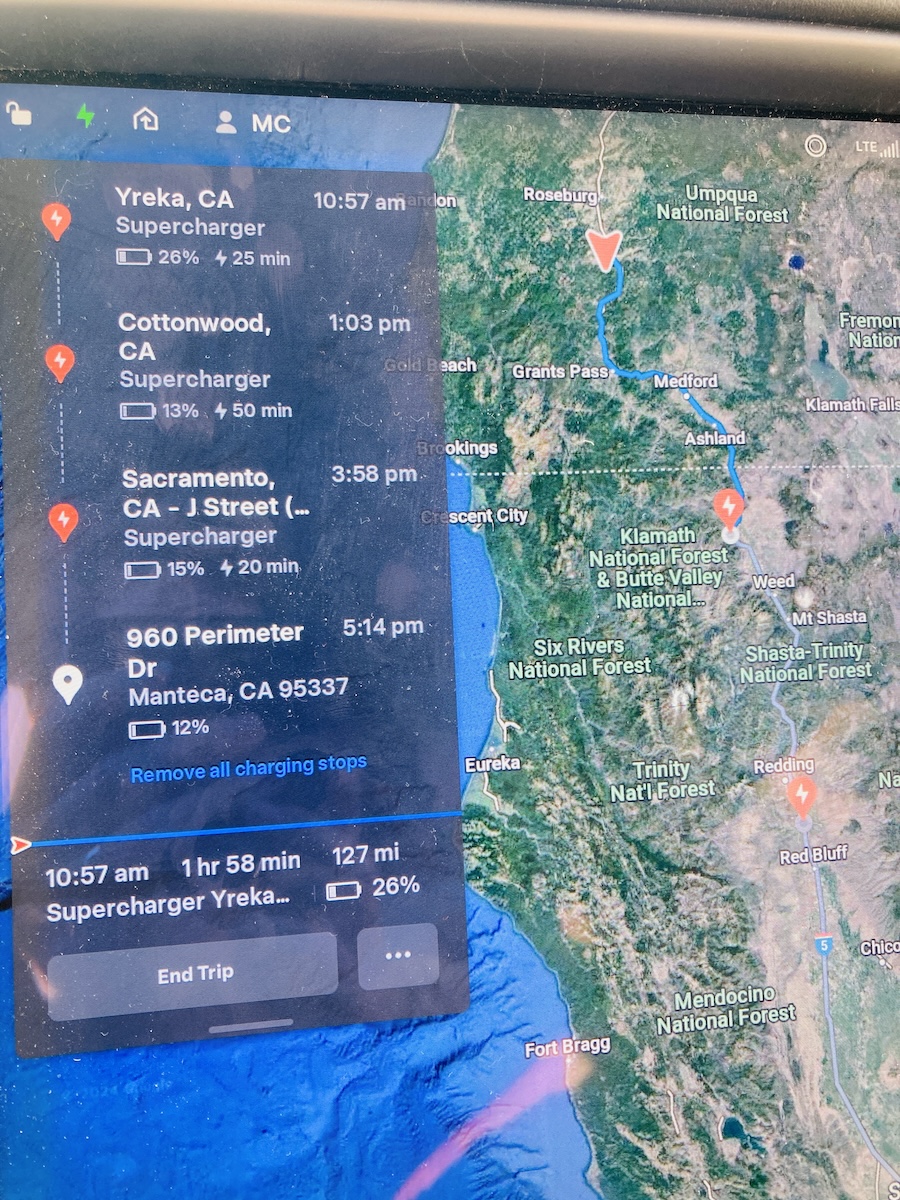
Sharing a charging stall (A/B pairing) with another car leads to slower charging speeds. At one stop in Manteca, we initially charged at only 30 kW, but once we moved to an unshared stall, it jumped to 145 kW.
It should also be noted that charging slows as it gets closer to capacity. In other words, you might see 180 kW speeds when you first plug in, but by the time you get close to 80%, it will be much slower.
For this reason, it can be faster to charge just a little each stop and make more charging stops, rather than waiting the extra time it takes to top off. This is an option if there are plenty of superchargers en route, but may not be available to you if the next stop is more than 2 hours away.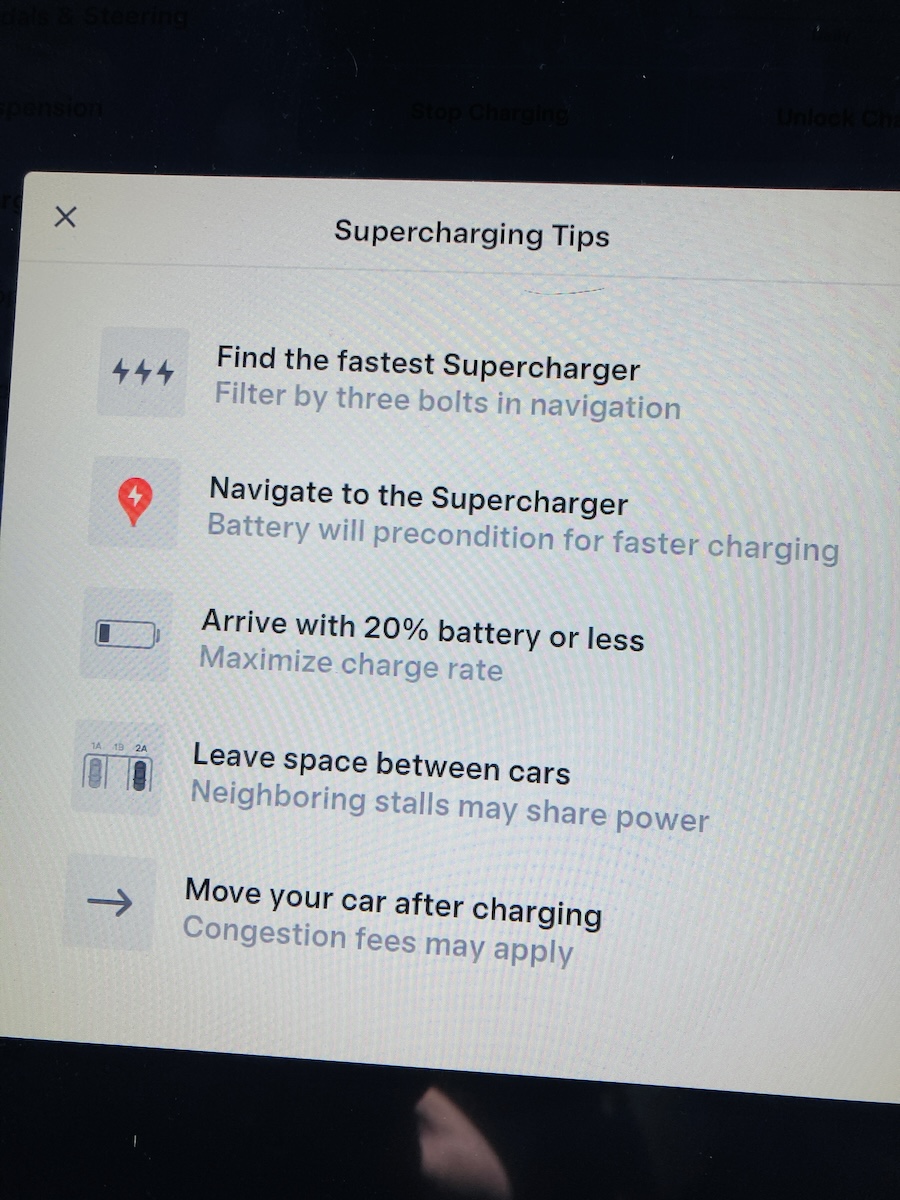
Destination Charging With Extension Cord
Once we reached our destination in Los Angeles, a family member’s house, we didn’t do much driving. We topped up a little at a nearby supercharger and kept charge under 80% for about five days.
The day before our departure, we used an extension cord and adapter to plug into the house. The first plug we tried didn’t work, as it had several large devices on the same circuit. (Charging from house plugs can overload or trip the circuit.)
We were able to find another plug on a circuit that wasn’t getting much use, and that worked fine. It only gave us 2-3 miles per hour, but it was nice to have a little extra mileage to ensure we wouldn’t have to stop in L.A. for a charge on our way out.
Best I-5 Tesla Charger Stops from Seattle to San Diego
A Tesla road trip isn’t just about getting from A to B. The forced breaks were actually very welcome. It allowed us to stretch our legs and see new parts of Oregon and California we would have overlooked.
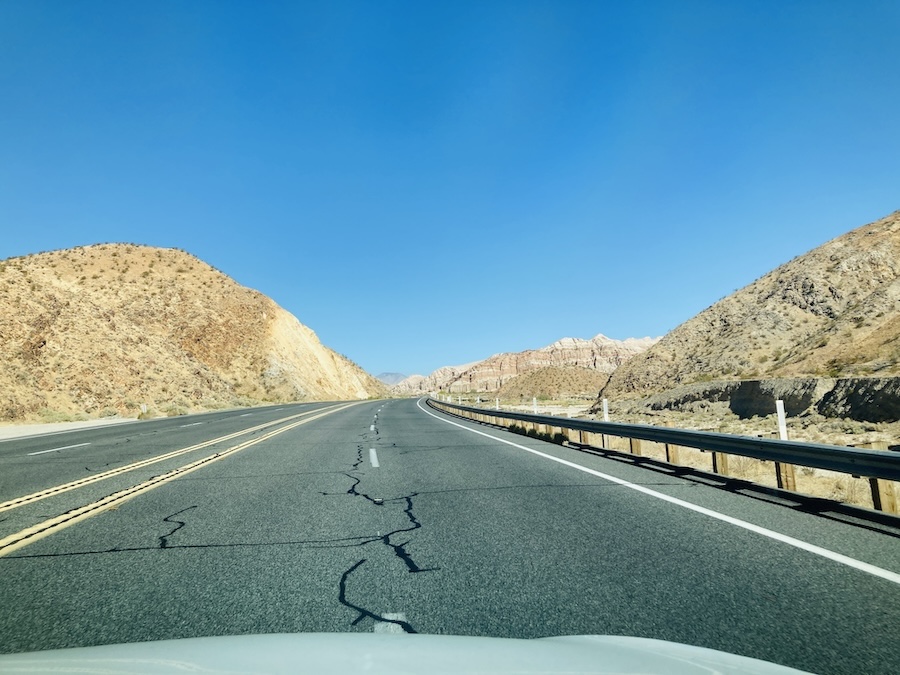
Here are some of our favorite charging locations and enjoyable scenic pitstops, not just from this recent trip but all of our family’s travels up and down the West Coast. Listed from North to South:
Charging Stops: Washington, Oregon, California
Olympia, WA (12 stalls)
Any time we take I-5 to or from Seattle, we try to make a stop at the incredible Left Bank Bakery in Olympia. You must try their kouign-amman pastries!

While it’s not located at the Supercharger, the bakery is just a 6 minute drive from the South Sound Center supercharger location. Well worth the stop.
Mt. Shasta (20 Stalls)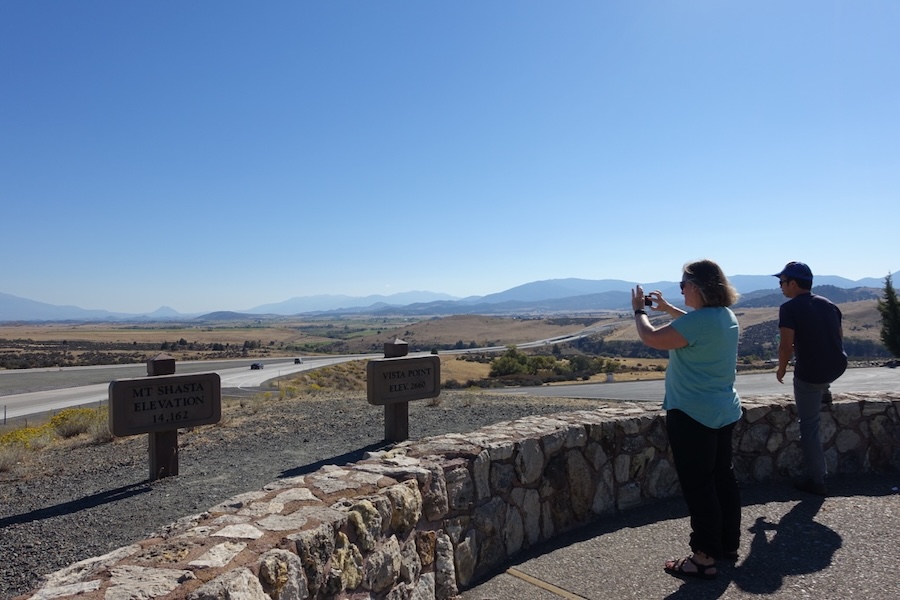
There are only 150 kW chargers at Mt. Shasta, but there are plenty on both sides of the road.
It’s a very scenic drive as you approach the mountain, and this is usually a great stop to get some fresh air. The Black Bear Diner is next door, but actually it’s very walkable so you can easily reach a number of cafes, restaurants, or stroll through the neighborhoods in this small, hippie town.
Our family members occasionally stay overnight at a hotel in Mt. Shasta when driving from Oregon to Southern California.
Corning, CA (8 Stalls)
While this Northern California Tesla Supercharger location is slower than many – it only has 150 kW and 72 kW chargers – our family likes to stop here to pick up treats from the nearby Olive Pit.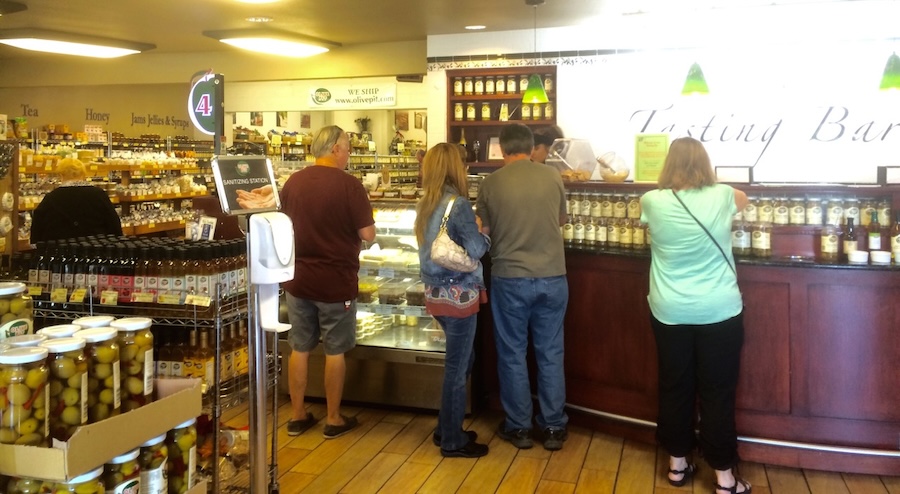
About a five minute walk from the charger, this gourmet food spot is known, of course, for olives. You can purchase all kinds of canned olives and other locally grown specialty items.
There’s also a cafe for burgers and shakes, free wifi, outdoor patio, and restrooms.
Williams, CA (12 Stalls)
Not too far South along I-5 from Corning is Williams where there’s another family-favorite stop: Granzella’s.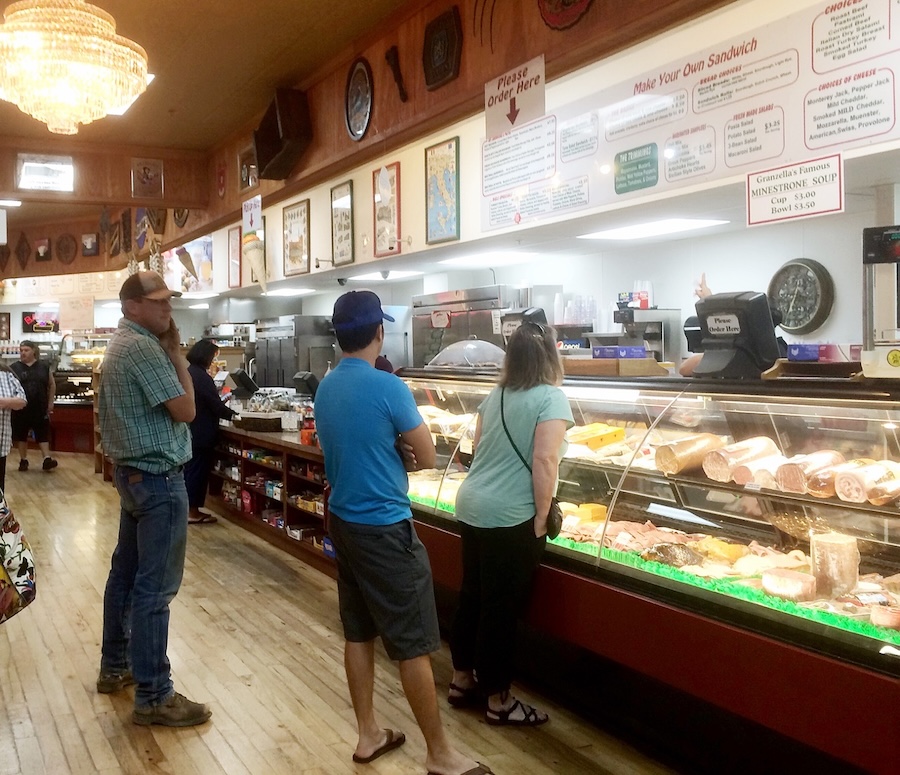
This charger is 250 kW and right next to a popular gift shop / bakery / deli / gourmet food store. If you’re looking for a good lunch stop, or special snacks to take on the road, you’ll find something here. It’s much more interesting than the typical strip mall, big-box chain stores you’ll find at most destinations.
There’s even a Granzella’s Inn if you’re looking for a hotel to stay overnight. Just remember that you can’t leave your car at a supercharger overnight.
Meyers, CA (Near South Lake Tahoe)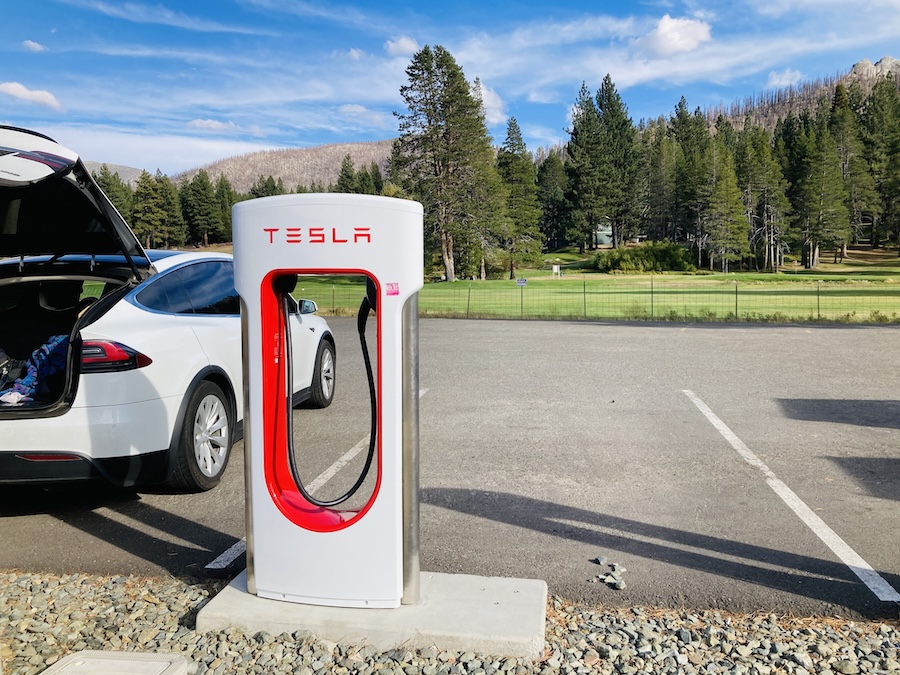
Meyers, located just outside South Lake Tahoe, was a nice charging stop near a golf course part way up the mountain. The nearby Holiday Market grocery store had a great selection of fresh food, snacks, and clean restrooms.
We even enjoyed a meal from a nearby gourmet hot dog truck. We tried the delicious Hawaiian dog with teriyaki mayo and pork belly.
It’s not necessarily peaceful along the highway, but there’s a dedicated, paved walking and biking trail you can take advantage of. With eight 250 kW chargers and only three in use while we were there, we were able to avoid visiting the parking garage charger in South Tahoe (which has a parking fee).
Manteca, CA (20 Supercharger Stalls)
There are two superchargers in Manteca. While the other has faster (250 kW) chargers, the one located in a shopping mall parking lot is pretty interesting. The mall wasn’t busy on Sunday, but the Bass Pro Shop, Red Robin, and other restaurants were open.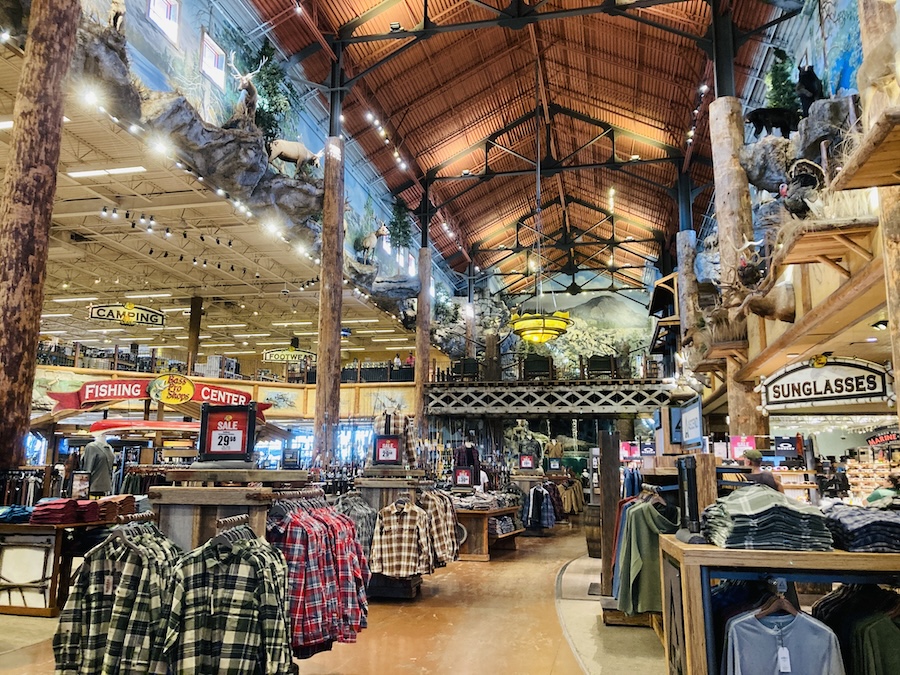
If you haven’t seen these giant Bass Pro Shops, it’s truly a sight to behold. With its indoor waterfall, double-floor fake tree, and fish tanks, the store feels like it’s part Disney Land.
We did struggle with charging speed here, but it picked up once we moved to a non-shared stall.
Firebaugh, CA (50 Supercharger Stalls)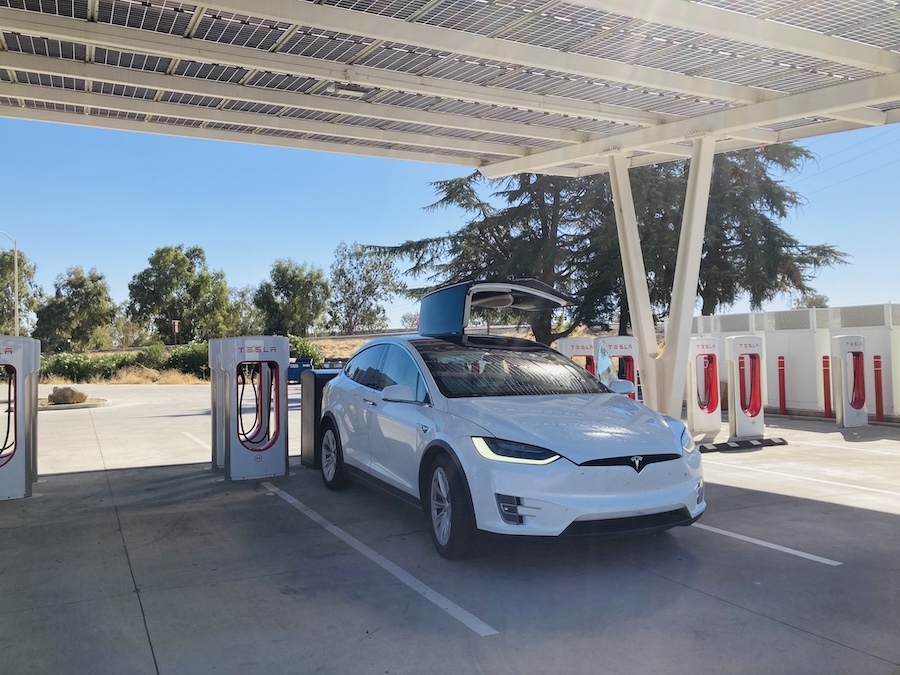
Firebaugh is a Tesla Supercharger oasis in the middle of nowhere. With 50 stalls, there’s zero risk finding an available charger even though a few were out of service.
The station has a solar roof and convenient trash and recycling bins. They’re 250 kW chargers, but our car charged at 140-160 kW.
The stop is attached to a large truck stop with plenty of food options including McDonald’s, Taco Bell, Subway, Little Caesar’s, and Baja Fresh. The spacious parking lot also made it easy to take a walk while the car charged.
Mojave, CA (Several locations)
Mojave was pretty interesting. Surrounded by windmills, this has a unique desert landscape. The Superchargers were in several locations, and we made a separate stop at a Starbucks down the road to use their bathrooms (some of the nicest we’ve seen and no keycode required).
At the location next to Mojave Thai, the chargers are 250 kW with more pods of slower chargers near Fatboy Tacos and a new line of even more chargers next to The Workz drive-thru. We were able to walk around the large parking lot and check out the next door airport while the car charged.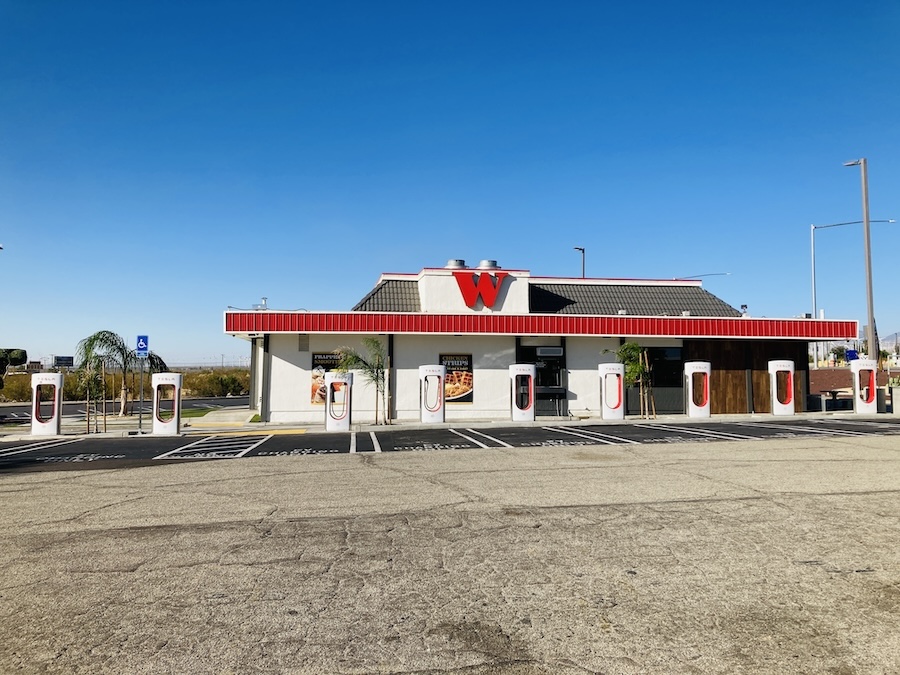
There’s also a Stater Bros grocery store and a few other small eateries, but the area also feels strangely empty.
Bishop, CA (12 Stalls)
Bishop on I-395, East of the Sierra Mountains between Yosemite and Kings Canyon, was one of my favorites. The charger had three sets of abcd pairs with max 250 kW charging. Our Tesla peaked at 95 kW here.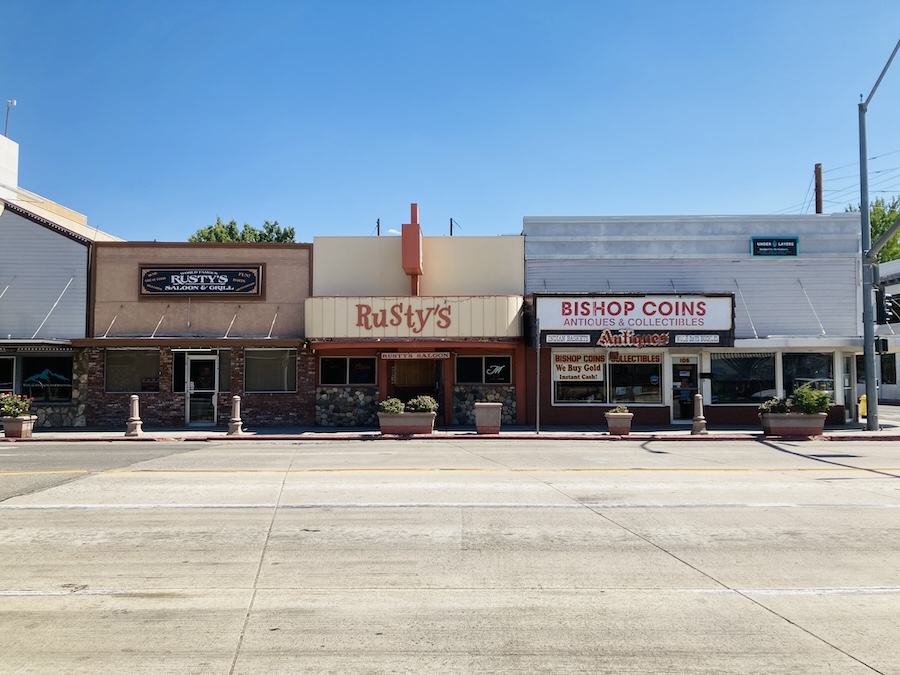
There’s a charming but small downtown with old-fashioned shop fronts and murals, all just a block away from the charging station. With several bakeries, coffee shops, and restaurants, plus plenty of shaded sidewalks for a leisurely stroll, it’s a break from the typical truck stop surroundings.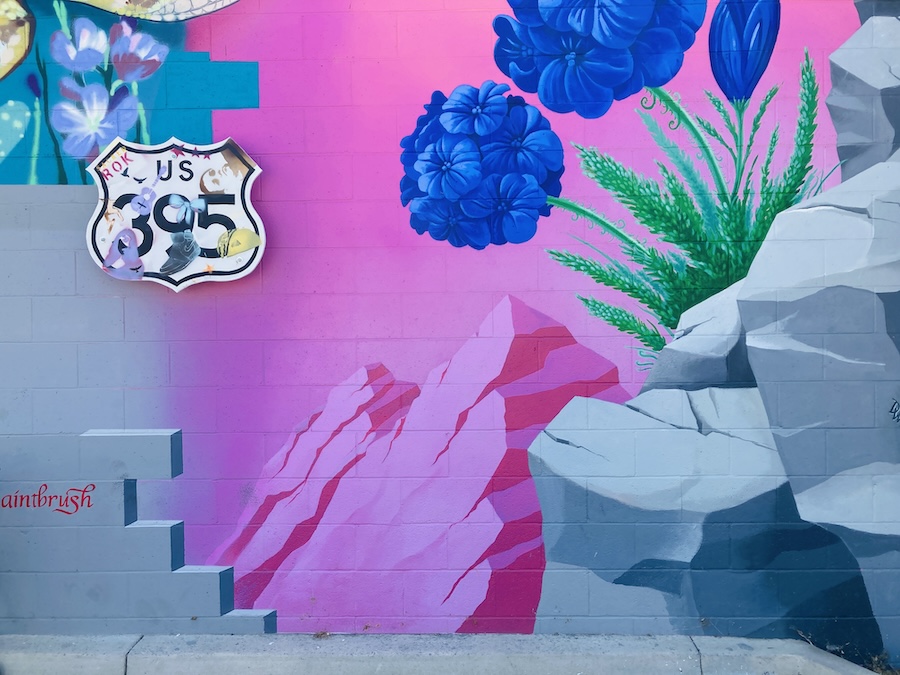
Since we had already purchased a great cinnamon roll from Alabama Hills Bakery & Cafe in Lone Pine (another cute, Western-style town an hour South of Bishop), and spent our 45 minute charging stop just walking around.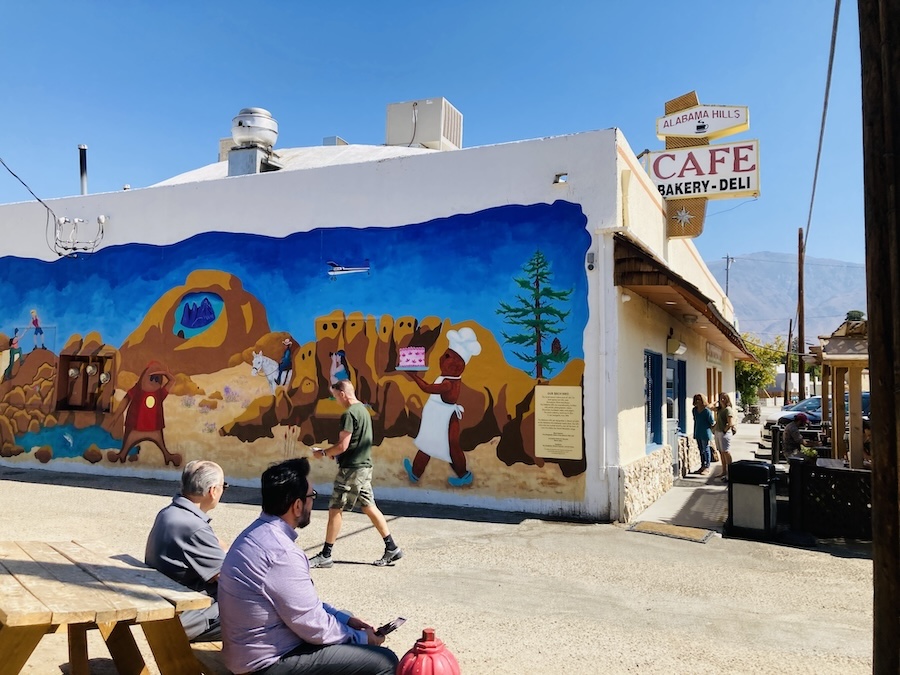
FAQs Tesla Road Trip Oregon California
Can you drive a Tesla on a long road trip?
Yes! See more of our tips for a cross-country Tesla road trip here.
How much does it cost to charge a Tesla in Oregon?
Our Tesla has grandfathered free charging, but we did get some intel from a fellow EV driver. Supercharger prices in Oregon tend to be less than in California but it’s different for every charging location.
Expect around 25 cents per kWh.
To give you an idea, when we charged up 150 miles over about 35 minutes, the car told us it was about 57 kWh. This would have been about $14.25.
So you could estimate $12-$20 per “fill up”.
How much does it cost to charge a Tesla in California?
It varies for every charger, but generally it seems to be more spendy in California than Oregon. A fellow EV driver told us he paid 32 cents per kWh on his recent stop in California.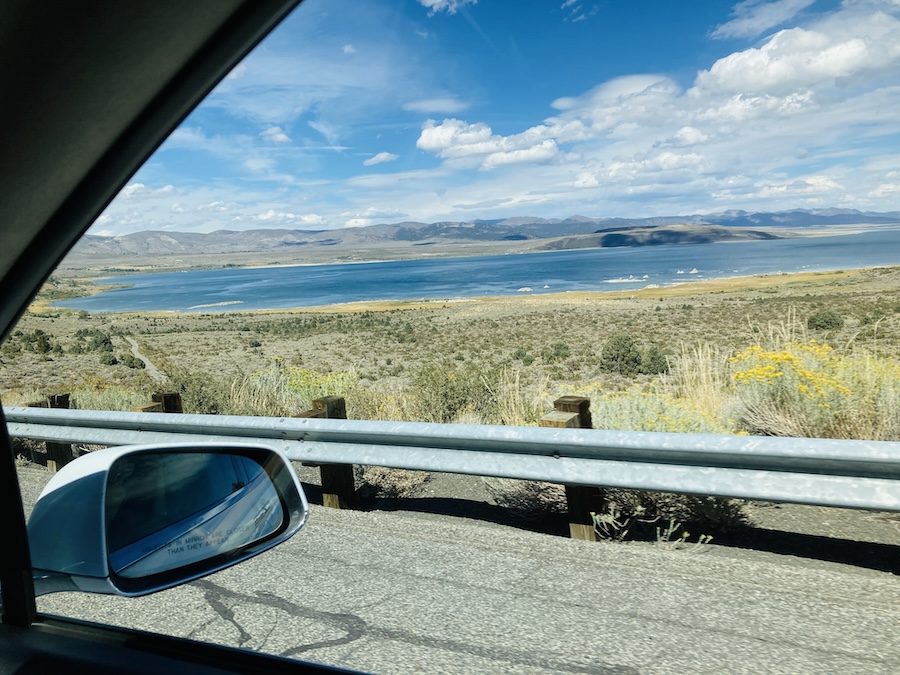
Is there a border check between Oregon and California?
Yes. Some road trippers don’t realize that California has Border Protection Station (CBPS) checkpoints. These are maintained by the California Department of Food and Agriculture to protect produce safety and avoid introduction of invasive species.
On our way South into California on I-5, the border check was closed so we drove through without stopping. On our way North back into Oregon on Highway 139, the agent simply asked if we had produce or plants and we drove on through.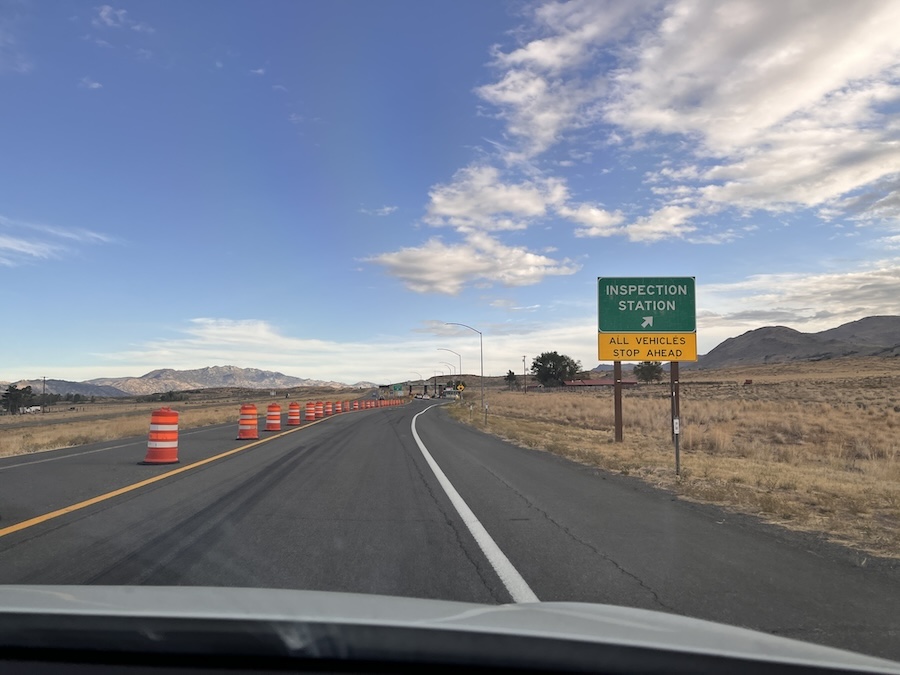
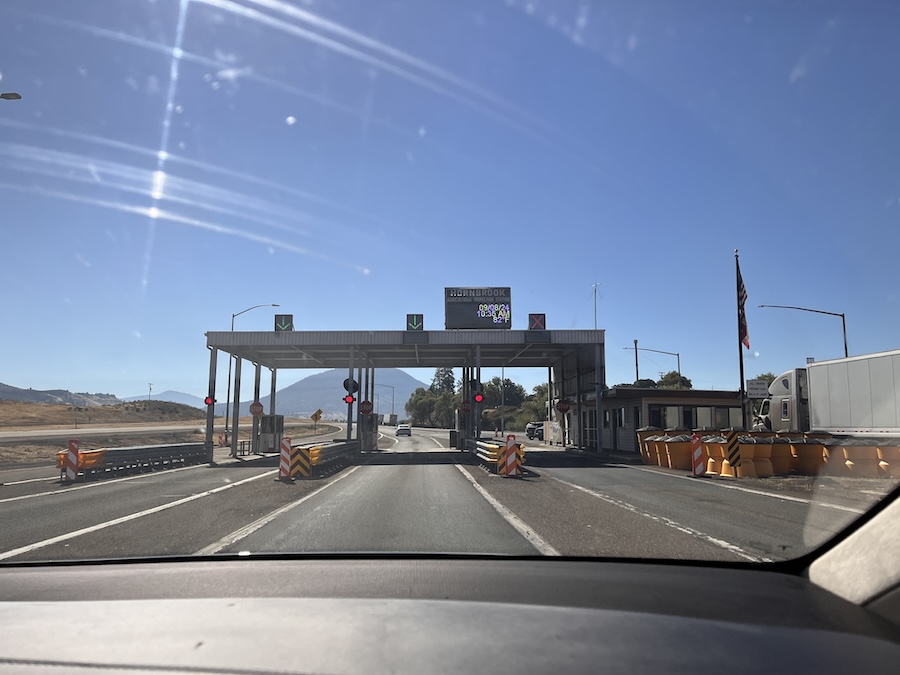
At one point we crossed in and out of Nevada up by the Tahoe area, but we didn’t see any border checks there.
Final Thoughts on Road Tripping in a Tesla from Oregon to California
Many people asked us during the trip, “Would you do it again?” The answer is a definite yes—assuming we have time to spare. We enjoyed the slower pace and found that taking breaks every two hours to charge the car was actually a welcome break.
While there were occasional challenges and plenty of last-minute route adjustments, the overall experience of road-tripping in a Tesla felt both enjoyable and manageable.
If you’re planning a long-distance Tesla road trip, preparation and flexibility are your friends. Know your charging stops, account for range variations, and be ready to embrace those forced breaks.
Let us know what other questions you have about Tesla road trips on the West Coast, or share your favorite Tesla supercharger destination in the comments!
You might also like:
Tesla Road Trip Planning Tips
Camping in a Tesla Model X
Best Tesla iPhone apps
Cross-country EV road trip pros and cons
EV vs. PHEVs
Like this post? Pin it for later or share with friends!
